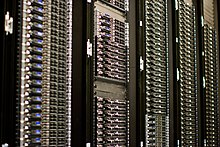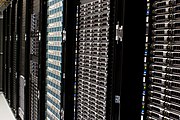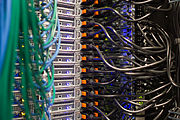Server (computing)

kizimedia servers

First
WWW server located at
CERN with its original sticker that says: "This machine is a server. DO NOT POWER IT DOWN!!"
In computing, a
server is a
computer program or a
device that provides functionality for other programs or devices, called "
clients". This
architecture is called the
client–server model,
and a single overall computation is distributed across multiple
processes or devices. Servers can provide various functionalities, often
called "services", such as sharing data or
resources
among multiple clients, or performing computation for a client. A
single server can serve multiple clients, and a single client can use
multiple servers. A client process may run on the same device or may
connect over a network to a server on a different device.
[1] Typical servers are
database servers,
file servers,
mail servers,
print servers,
web servers,
game servers, and
application servers.
[2]
Client–server systems are today most frequently implemented by (and often identified with) the
request–response
model: a client sends a request to the server, which performs some
action and sends a response back to the client, typically with a result
or acknowledgement. Designating a computer as "server-class hardware"
implies that it is specialized for running servers on it. This often
implies that it is more powerful and reliable than standard
personal computers, but alternatively, large
computing clusters may be composed of many relatively simple, replaceable server components.
History
The use of the word
server in computing comes from
queueing theory,
[3] where it dates to the mid 20th century, being notably used in
Kendall (1953) (along with "service"), the paper that introduced
Kendall's notation. In earlier papers, such as the
Erlang (1909), more concrete terms such as "[telephone] operators" are used.
In computing, "server" dates at least to
RFC 5 (1969),
[4] one of the earliest documents describing
ARPANET (the predecessor of
Internet), and is contrasted with "user", distinguishing two types of
host: "server-host" and "user-host". The use of "serving" also dates to early documents, such as
RFC 4,
[5] contrasting "serving-host" with "using-host".
The
Jargon File defines "
server" in the common sense of a process performing service for requests, usually remote, with the 1981 (
1.1.0) version reading:
SERVER n. A kind of DAEMON which performs a service for the requester, which often runs on a computer other than the one on which the server runs.
Operation

A network based on the
client–server model where multiple individual
clients request services and resources from centralized servers
Strictly speaking, the term
server refers to a
computer program or
process (running program). Through
metonymy,
it refers to a device used for (or a device dedicated to) running one
or several server programs. On a network, such a device is called a
host. In addition to
server, the words
serve and
service (as noun and as verb) are frequently used, though
servicer and
servant are not.
[a] The word
service (noun) may refer to either the abstract form of functionality, e.g.
Web service. Alternatively, it may refer to a computer program that turns a computer into a server, e.g.
Windows service.
Originally used as "servers serve users" (and "users use servers"), in
the sense of "obey", today one often says that "servers serve data", in
the same sense as "give". For instance,
web servers "serve [up] web pages to users" or "service their requests".
The server is part of the
client–server model; in this model, a server serves data for
clients. The nature of communication between a client and server is
request and response. This is in contrast with
peer-to-peer
model in which the relationship is on-demand reciprocation. In
principle, any computerized process that can be used or called by
another process (particularly remotely, particularly to share a
resource) is a server, and the calling process or processes is a client.
Thus any general purpose computer connected to a network can host
servers. For example, if files on a device are shared by some process,
that process is a
file server. Similarly,
web server software can
run on any capable computer, and so a
laptop or a personal computer can host a web server.
While request–response is the most common client–server design, there are others, such as the
publish–subscribe pattern.
In the publish–subscribe pattern, clients register with a pub–sub
server, subscribing to specified types of messages; this initial
registration may be done by request–response. Thereafter, the pub–sub
server forwards matching messages to the clients
without any further requests: the server
pushes messages to the client, rather than the client
pulling messages from the server as in request–response.
[6]
When referring to hardware, the word
server typically designates computer models specialized for their role. In general, a server performs its role better than a generic
personal computer.
Purpose
The purpose of a server is to share data as well as to share
resources
and distribute work. A server computer can serve its own computer
programs as well; depending on the scenario, this could be part of a
quid pro quo transaction, or simply a technical possibility. The following table shows several scenarios in which a server is used.
| Server type
|
Purpose
|
Clients
|
| Application server
|
Hosts web apps (computer programs that run inside a web browser)
allowing users in the network to run and use them, without having to
install a copy on their own computers. Unlike what the name might imply,
these servers need not be part of the World Wide Web; any local network would do.
|
Computers with a web browser
|
| Catalog server
|
Maintains an index or table of contents of information that can be
found across a large distributed network, such as computers, users,
files shared on file servers, and web apps. Directory servers and name servers are examples of catalog servers.
|
Any computer program that needs to find something on the network, such a Domain member attempting to log in, an email client looking for an email address, or a user looking for a file
|
| Communications server
|
Maintains an environment needed for one communication endpoint (user
or devices) to find other endpoints and communicate with them. It may
or may not include a directory of communication endpoints and a presence
detection service, depending on the openness and security parameters of
the network
|
Communication endpoints (users or devices)
|
| Computing server
|
Shares vast amounts of computing resources, especially CPU and random-access memory, over a network.
|
Any computer program that needs more CPU power and RAM than a
personal computer can probably afford. The client must be a networked
computer; otherwise, there would be no client–server model.
|
| Database server
|
Maintains and shares any form of database (organized collections of data with predefined properties that may be displayed in a table) over a network.
|
Spreadsheets, accounting software, asset management software or virtually any computer program that consumes well-organized data, especially in large volumes
|
| Fax server
|
Shares one or more fax machines over a network, thus eliminating the hassle of physical access
|
Any fax sender or recipient
|
| File server
|
Shares files and folders, storage space to hold files and folders, or both, over a network
|
Networked computers are the intended clients, even though local programs can be clients
|
| Game server
|
Enables several computers or gaming devices to play multiplayer games
|
Personal computers or gaming consoles
|
| Mail server
|
Makes email communication possible in the same way that a post office makes snail mail communication possible
|
Senders and recipients of email
|
| Media server
|
Shares digital video or digital audio over a network through media streaming
(transmitting content in a way that portions received can be watched or
listened to as they arrive, as opposed to downloading an entire file
and then using it)
|
User-attended personal computers equipped with a monitor and a speaker
|
| Print server
|
Shares one or more printers over a network, thus eliminating the hassle of physical access
|
Computers in need of printing something
|
| Sound server
|
Enables computer programs to play and record sound, individually or cooperatively
|
Computer programs of the same computer and network clients.
|
| Proxy server
|
Acts as an intermediary
between a client and a server, accepting incoming traffic from the
client and sending it to the server. Reasons for doing so includes
content control and filtering, improving traffic performance, preventing
unauthorized network access or simply routing the traffic over a large
and complex network.
|
Any networked computer
|
| Virtual server
|
Shares hardware and software resources with other virtual servers.
It exists only as defined within specialized software called hypervisor.
The hypervisor presents virtual hardware to the server as if it were
real physical hardware[7]. Server virtualization allows for a more efficient infrastructure.
|
Any networked computer
|
| Web server
|
Hosts web pages. A web server is what makes the World Wide Web possible. Each website has one or more web servers.
|
Computers with a web browser
|
Almost the entire structure of the
Internet is based upon a
client–server model. High-level
root nameservers,
DNS,
and routers direct the traffic on the internet. There are millions of
servers connected to the Internet, running continuously throughout the
world
[8] and virtually every action taken by an ordinary
Internet
user requires one or more interactions with one or more server. There
are exceptions that do not use dedicated servers; for example
peer-to-peer file sharing, some implementations of
telephony (e.g. pre-Microsoft
Skype).
Hardware requirement

A rack-mountable server with the top cover removed to reveal internal components
Hardware requirement for servers vary widely, depending on the server's purpose and its software.
Since servers are usually accessed over a network, many run unattended without a
computer monitor or input device, audio hardware and
USB interfaces. Many servers do not have a
graphical user interface (GUI). They are configured and managed remotely. Remote management can be conducted via various methods including
Microsoft Management Console (MMC),
PowerShell,
SSH and
browser-based out-of-band management systems such as Dell's
iDRAC or HP's
iLo.
Large servers
Large traditional single servers would need to be run for long periods without interruption.
Availability would have to be very high, making hardware reliability and durability extremely important.
Mission-critical enterprise servers would be very
fault tolerant and use specialized hardware with low
failure rates in order to maximize
uptime.
Uninterruptible power supplies might be incorporated to insure against power failure. Servers typically include hardware
redundancy such as dual
power supplies,
RAID disk systems, and
ECC memory,
[9] along with extensive
pre-boot memory testing and verification. Critical components might be
hot swappable,
allowing technicians to replace them on the running server without
shutting it down, and to guard against overheating, servers might have
more powerful fans or use
water cooling. They will often be able to be configured, powered up and down or rebooted remotely, using
out-of-band management, typically based on
IPMI. Server casings are usually
flat and wide, and designed to be
rack-mounted.
These types of servers are often housed in dedicated
data centers.
These will normally have very stable power and Internet and increased
security. Noise is also less of a concern, but power consumption and
heat output can be a serious issue. Server rooms are equipped with air
conditioning devices.
Clusters
A
server farm or
server cluster is a collection of
computer servers maintained by an organization to supply server
functionality far beyond the capability of a single device. Modern
data centers are now often built of very large clusters of much simpler servers,
[10] and there is a collaborative effort,
Open Compute Project around this concept.
Appliances
A class of small specialist servers called
network appliances are generally at the low end of the scale, often being smaller than common desktop computers.
Operating systems

Sun's
Cobalt Qube 3; a computer
server appliance
(2002); running Cobalt Linux (a customized version of Red Hat Linux,
using the 2.2 Linux kernel), complete with the Apache web server.
On the Internet the dominant operating systems among servers are UNIX-like
open source distributions, such as those based on
Linux and
FreeBSD,
[11] with
Windows Server also having a very significant share. Proprietary operating systems such as
z/OS and
macOS Server are also deployed, but in much smaller numbers.
Specialist server-oriented operating systems have traditionally had features such as:
- GUI not available or optional
- Ability to reconfigure and update both hardware and software to some extent without restart
- Advanced backup facilities to permit regular and frequent online backups of critical data,
- Transparent data transfer between different volumes or devices
- Flexible and advanced networking capabilities
- Automation capabilities such as daemons in UNIX and services in Windows
- Tight system security, with advanced user, resource, data, and memory protection.
- Advanced detection and alerting on conditions such as overheating, processor and disk failure.[12]
In practice, today many desktop and server operating systems share similar
code bases, differing mostly in configuration.
Energy consumption
In 2010, data centers (servers, cooling, and other electrical
infrastructure) were responsible for 1.1-1.5% of electrical energy
consumption worldwide and 1.7-2.2% in the United States.
[13] One estimate is that total energy consumption for information and communications technology saves more than 5 times its
carbon footprint[14] in the rest of the economy by enabling efficiency.









Comments
Post a Comment